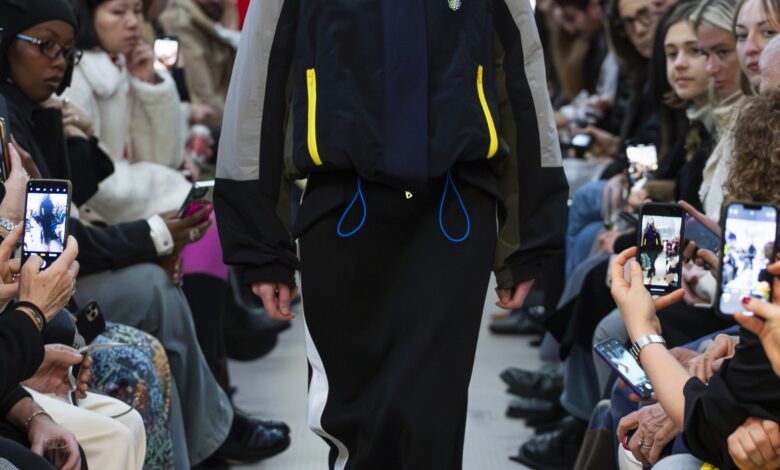Meryll Rogge Fall 2024 Ready-to-Wear

Meryll Rogge staged a fashion show in a locker-lined basement of the École Duperré, where she also hosted an after-party to mark four years in business. “It’s really difficult for young brands today, and the fact that we’re still here is a great thing for all of us, so we wanted to celebrate,” said the designer on a pre-show Zoom. (Note the festive, spangled silver disco-ball sweater, Look 14.)
That post-show fête was advertised with posters that took their graphic style from the “new beat ’90s era” in Belgium that the designer grew up in. Underground parties were a big part of that house scene, and Rogge imagined someone receiving an invitation to one of them on a Nokia phone while at home or at soccer practice and cobbling an outfit together as they headed out for an evening that was centered on music and dancing rather than ’fit pics. The flip-phone aspect is important here; the spontaneous aesthetic Rogge is after relates to a way of living that no longer exists in this digital age of constant documentation, filters and surveillance.
The first exit, a chic tracksuit accessorized with sport socks and high-heel sandals, was an example of how the designer linked freedom of expression and movement to a celebratory air. We’re sure to see more athleisure as the Olympics approach, and Rogge has established a lead there. Updated vintage references are a key part of this Marc Jacobs alum’s work, and grandpa-style fabrics were worked into tailored back-buttoned dressmaker shaped tops and dresses. Grandmother was represented by ’50s-ish big-shouldered mohair cardigans with crochet and beading, as well as sofa prints. The paisley, said Rogge, was “a bit inspired by Nan Goldin images” taken in interiors; the rose was cut off of an actual couch and scanned and reworked. Clear rainwear styled over that print played with the idea of the plastic-protected sofa. Preservation, or continuation, must have been on the designer’s mind as she marked an anniversary, but on the whole this collection seemed to celebrate youth rather than mourn its passing. In fact the link between the post-war era, when the idea of the teenager really started to take hold, with Rogge’s own salad days in the ’90s tells a story of continuity and continuance. With the exception of some puzzling blush-colored satin pieces, this collection was full of garments sure to appeal to one’s inner (wild) child.


